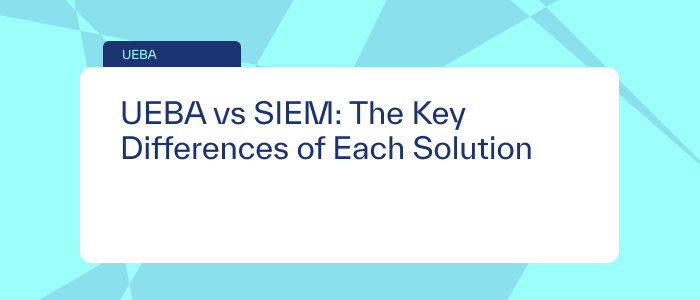
What is UEBA? User and Entity Behavior Analytics (UEBA) is a cybersecurity solution that analyzes the behavior of users and machine entities using machine learning and mathematical algorithms to detect anomalies that may indicate risk to the organization.
Security Information and Event Management (SIEM, pronounced “sim”) provides security professionals with a centralized view of their organization’s security events. SIEM systems collect and analyze security-related data from multiple sources, use advanced analytics and correlation techniques to identify potential security threats, and provide real-time alerts and automated response actions.
By integrating SIEM and UEBA tools, organizations can achieve a more comprehensive and proactive security posture. SIEM provides event correlation, log management, and real-time monitoring, while UEBA cyber security enhances threat detection by focusing on user and entity behavior analysis. Together, they offer improved visibility, faster incident response, and better protection against advanced threats.
UEBA is the scientific process of transforming behavior data from human users and entities such as servers, routers, endpoints, and IoT devices into risk-prioritized intelligence, for the purpose of driving business action. It’s the application of data science to create user and entity behavior baselines from months of historical access and activity. Once behavior baselines are established, analytics is used to monitor user and entity behavior in real time, for the purposes of predicting and detecting anomalous activity. The output of security analytics is a single risk score for every user and entity. The risk score provides actionable intelligence on potential risky situations in real-time so organizations can take corrective action.
Because UEBA works on subtle changes in behavior of both human users and machine entities, it can detect a variety of cyber-attacks, including insider threats, account takeovers, stolen credentials, ransomware attacks, brute force attacks, DDoS attacks, compromised devices, and more. UEBA uncovers risk from known as well as unknown threats.
UEBA solutions are utilized by a variety of organizations across different industries, but typically it is those that have extensive user bases, complex networks, or valuable digital assets that make them prime targets for cyber threats. Among the common users are financial institutions, healthcare providers, government agencies, operators of critical infrastructure, and technology companies.
UEBA enhances an organization’s security posture by leveraging behavioral analytics, machine learning, and automation to identify and respond to advanced threats effectively. It improves threat detection capabilities, reduces response times, and provides valuable insights into user behavior for proactive security measures.
Some of the key advantages of using UEBA include:
A SIEM system is a cybersecurity tool that provides organizations with a centralized and holistic view of their IT infrastructure’s security by collecting, correlating, and analyzing security events and logs from various sources.
The key components and functionalities of a SIEM system include:
By using well-defined rules, correlation techniques, and threat intelligence feeds, SIEM systems can detect a wide range of threats and security incidents within an organization’s IT infrastructure.
Some of the common threats that SIEM can detect include:
SIEM systems are used by various organizations and entities across different industries. While larger organizations often have dedicated resources for managing SIEM systems, smaller organizations may rely on managed SIEM services or cloud-based SIEM solutions provided by third-party vendors.
Some of the typical users of SIEM include:
SIEM systems provide organizations with better visibility into their security posture, early detection of security incidents, streamlined incident response processes, and improved compliance management. They play a critical role in enhancing security operations, mitigating risks, and protecting sensitive data and assets.
Here are some of the key advantages of using SIEM:
UEBA and SIEM are two distinct cybersecurity technologies that serve different purposes but can be complementary in an organization’s security strategy. Here’s a comparison of the two:
SIEM focuses on aggregating, correlating, and analyzing security events and logs from various sources across an organization’s IT infrastructure. It aims to detect and respond to security incidents by monitoring and analyzing network activity, system logs, and security events.
SIEM collects and correlates data from a broad range of sources, such as firewalls, intrusion detection systems, antivirus systems, servers, and applications. It includes logs and events from network devices, security devices, operating systems, and applications.
SIEM utilizes predefined rules, correlation techniques, and threat intelligence to identify patterns, signatures, or indicators of compromise. It detects security incidents by correlating events from different sources and applying rules and logic to detect patterns of malicious or suspicious behavior.
SIEM provides a broader scope of analysis by correlating and analyzing security events and logs from various sources. It looks for patterns and indicators of security incidents, including network intrusions, malware infections, policy violations, data breaches, and other security-related events.
Combining SIEM with UEBA can provide organizations with a more comprehensive and powerful security solution. Here are some benefits and outcomes of integrating SIEM with UEBA:
SIEM and UEBA are two popular cybersecurity tools that organizations use to detect threats in their environments. The threat detection tools serve different purposes, using different kinds of data, but they can be complementary to each other when used together. Combining SIEM with UEBA can provide organizations with a more comprehensive and powerful security solution.
About The Author
 Jane Grafton, VP Marketing, Gurucul
Jane Grafton, VP Marketing, Gurucul
Jane Grafton has more than 30 years of experience in domestic and international marketing, sales and business development. She came to Gurucul from Lieberman Software where she spent 9 years managing global marketing operations inclusive of marketing automation, website, events, collateral, digital marketing, email campaigns, product marketing, PR and corporate branding. Prior to that she spent 12 years at Sun Microsystems in field marketing management, supporting commercial accounts and federal systems integrators throughout the U.S. Prior to Sun, Mrs. Grafton sold and developed new markets for Locus Computing Corporation’s UNIX software services focusing on OEMs. At Computer Associates Limited in the UK, she established a new corporate function, Third Party Marketing, by developing relationships with hardware manufacturers, distributors and management consultants. Mrs. Grafton graduated from UC San Diego, CA in Applied Mathematics.
UEBA transforms behavior data from human users and entities such as servers, routers, endpoints, and IoT devices into risk-prioritized intelligence, for the purpose of driving business action. Data science is used to create user and entity behavior baselines from months of historical access and activity. Once behavior baselines are established, analytics monitor user and entity behavior in real-time, for the purposes of predicting and detecting anomalous activity. Real-time is the key here: analytics ingests massive amounts of data and provides insight into what’s actually going on with users and entities in an organization, as it’s happening. The output of security analytics is a single risk score for every user and entity. The risk score provides actionable intelligence on potential risky situations in real-time so organizations can take corrective action.
The single most critical factor in differentiating merely anomalous behavior from risky behavior is context. That context comes from the three pillars of behavior: identity, access, and activity. Detecting and stopping insider threats and cybercriminals involves monitoring and linking all three.
